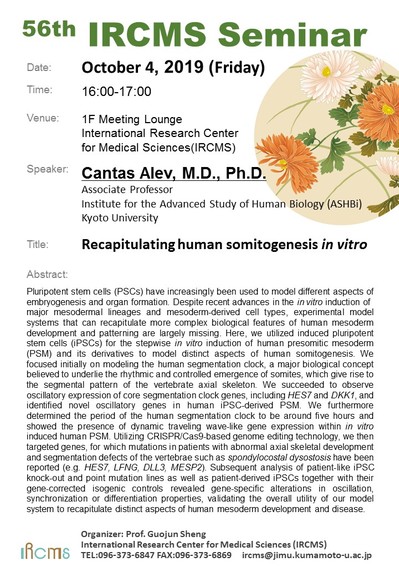Events
[October 4] 56th IRCMS Seminar
September 18 2019
We would like to inform you that the 56th IRCMS Seminar has been scheduled as below. We would be pleased to see many of you participating in the seminar.
Date : October 4, 2019 (Friday)
Time : 16:00-17:00
Venue : IRCMS 1F Meeting Lounge
Speaker : Cantas Alev, M.D., Ph.D.
Associate Professor
Institute for the Advanced Study of Human Biology (ASHBi)
Kyoto University
Tilte : Recapitulating human somitogenesis in vitro
Abstract:
Pluripotent stem cells (PSCs) have increasingly been used to model different aspects of embryogenesis and organ formation. Despite recent advances in the in vitro induction of major mesodermal lineages and mesoderm-derived cell types, experimental model systems that can recapitulate more complex biological features of human mesoderm development and patterning are largely missing. Here, we utilized induced pluripotent stem cells (iPSCs) for the stepwise in vitro induction of human presomitic mesoderm (PSM) and its derivatives to model distinct aspects of human somitogenesis. We focused initially on modeling the human segmentation clock, a major biological concept believed to underlie the rhythmic and controlled emergence of somites, which give rise to the segmental pattern of the vertebrate axial skeleton. We succeeded to observe oscillatory expression of core segmentation clock genes, including HES7 and DKK1, and identified novel oscillatory genes in human iPSC-derived PSM. We furthermore determined the period of the human segmentation clock to be around five hours and showed the presence of dynamic traveling wave-like gene expression within in vitro induced human PSM. Utilizing CRISPR/Cas9-based genome editing technology, we then targeted genes, for which mutations in patients with abnormal axial skeletal development and segmentation defects of the vertebrae such as spondylocostal dysostosis have been reported (e.g. HES7, LFNG, DLL3, MESP2). Subsequent analysis of patient-like iPSC knock-out and point mutation lines as well as patient-derived iPSCs together with their gene-corrected isogenic controls revealed gene-specific alterations in oscillation, synchronization or differentiation properties, validating the overall utility of our model system to recapitulate distinct aspects of human mesoderm development and disease.
